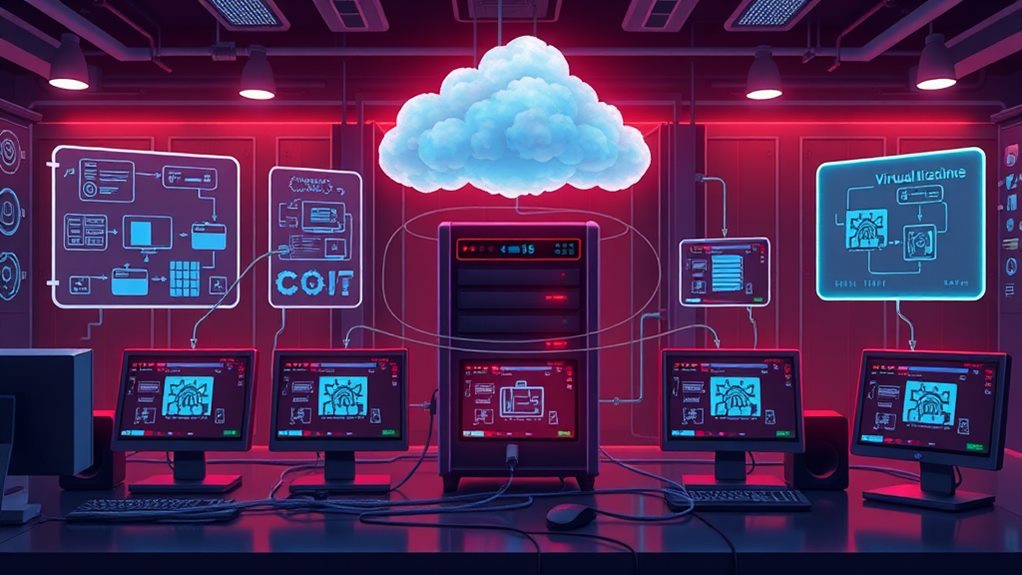Virtualizing Mini PCs offers you incredible benefits, transforming compact devices into versatile IT solutions. You get improved performance by efficiently managing workloads while enhancing resource utilization. It’s cost-effective too, cutting operational costs through lower power consumption. With the ability to run multiple virtual machines, you can experiment with different applications without the clutter of physical hardware. Security and management become simpler as you can monitor performance and implement updates easily. Plus, as your needs grow, scaling is straightforward. If you’re curious about optimizing your setup even further, there’s more to uncover.
Key Takeaways
- Optimize Performance with Mini PC Virtualization – Transform compact devices into powerful solutions that efficiently manage workloads while reducing operational costs through 50-70% lower power consumption.
- Select Robust Hardware Configurations – Guarantee superior virtualization performance by choosing Mini PCs with capable CPUs, at least 32GB of RAM, and appropriate hypervisor software like Proxmox or VMware that supports essential virtualization technologies.
- Implement Comprehensive Security Measures – Protect your virtualized environment through regular monitoring, security patches, robust network protection, and structured backup strategies to safeguard against emerging threats.
- Scale Seamlessly as Needs Grow – Effortlessly expand your virtualized infrastructure by integrating additional Mini PC units, upgrading hardware components, and implementing load balancing to maintain ideal resource utilization.
- Embrace Future-Ready Technologies – Position yourself at the forefront of computing trends by leveraging Mini PCs for edge computing, containerization, and sustainable IT operations that align with corporate environmental goals.
Advantages of Mini PCs
When it comes to choosing a computing solution, Mini PCs stand out for several compelling reasons. First and foremost, their small form factor allows you to integrate them into any workspace, making them perfect for users with limited space. You can effortlessly fit a Mini PC on your desk, in a closet, or even discreetly behind your monitor.
Many Mac users find that enhancing computing power with a Mini PC allows them to run Windows programs alongside macOS, which is a significant advantage for multitasking.
Additionally, Mini PCs are highly cost-effective, often costing 50-70% less than traditional desktops. This significant saving makes them an appealing choice for budget-conscious users who still crave performance.
Their energy-efficient designs lead to lower power consumption, aligning with sustainability goals while also reducing your operational costs over time.
You’ll also appreciate the versatility Mini PCs offer, catering to a wide range of workloads—whether you’re tackling basic tests or handling more demanding production tasks.
Plus, with many models featuring quiet operation thanks to fanless designs or silent cooling solutions, they’re ideal for noise-sensitive environments, allowing you to concentrate without distractions.
In short, virtualizing Mini PCs are an innovative solution that balances performance, savings, and a commitment to energy efficiency.
Setting Up Virtualization

Virtualizing Mini PCs requires careful consideration of both hardware and software aspects. First, you’ll want to select a model equipped with a capable CPU and at least 32GB of RAM, as this is vital for handling multiple virtual machines (VMs) efficiently. Additionally, guarantee that your Mini PC has features like energy efficiency to reduce operational costs.
Next, choose a hypervisor that meets your needs—options like Proxmox, VMware Workstation, or Hyper-V are popular for their robust features. Make certain your chosen hypervisor supports fundamental virtualization technologies like Intel VT-x or AMD-V.
Installing the hypervisor typically involves downloading the software and creating a bootable USB drive or installing it directly onto the Mini PC. Once that’s done, you can configure the VM settings. Allocate appropriate CPU cores, RAM, and storage for each VM, avoiding resource overcommitment to maintain stability.
After creating your VMs, proceed to install the guest operating systems. Don’t forget to configure networking settings to facilitate communication between VMs and the host system. This step is vital for guaranteeing efficient operation of your virtualized environment.
With these setups in place, you’ll release the full potential of your Mini PC through virtualization.
Management and Security

Effective management and security of your virtualized environment are fundamental, especially as the number of virtual machines (VMs) increases. Regular monitoring of your VMs through hypervisor tools can help track performance metrics and resource usage, guaranteeing that your setup operates efficiently.
By employing advanced machine learning algorithms, you can proactively identify performance bottlenecks and automatically distribute workloads, improving resource utilization. Additionally, disaster recovery solutions can further safeguard your virtual environment, guaranteeing quick recovery from data breaches or system failures.
Robust network security measures, including firewalls and VPNs, are essential to protect both host and guest environments from emerging threats. Don’t overlook the importance of periodic updates for your hypervisor and guest operating systems; applying the latest security patches can greatly reduce vulnerabilities.
Implementing a well-structured backup strategy with regular snapshots helps create effective recovery points, allowing you to swiftly restore VMs in case of data loss or system failures.
Finally, conducting periodic audits to assess security and compliance is crucial. This guarantees adherence to regulatory standards and protects sensitive data, giving you peace of mind.
Scaling Virtualized Environments

Scaling virtualized environments with mini PCs offers a dynamic solution to meet your growing computing needs. By utilizing devices like the Beelink SER, you can effortlessly integrate additional units to support more virtual machines, enhancing both capacity and flexibility. This approach is particularly advantageous if you’re working with limited space, as mini PCs can fit in tight spots while still delivering powerful performance.
Here’s a quick overview of the scaling benefits:
| Benefit | Description | Impact |
|---|---|---|
| Hardware Upgrades | Improve RAM and storage for increased workloads | Higher performance |
| Load Balancing | Distribute workloads evenly across mini PCs | ideal resource utilization |
| Resource Monitoring | Analyze utilization trends for informed scaling | Strategic hardware decisions |
Using scalable virtualization solutions like Proxmox or VMware guarantees that your mini PC setup can seamlessly grow with your requirements. By monitoring resource utilization, you can identify when it’s time to expand, guaranteeing you maintain an efficient and effective virtual environment. With smart scaling strategies, your infrastructure can evolve without the hassle of complete system replacements.
Future Trends in Virtualization

As the landscape of virtualization evolves, numerous trends are shaping the way organizations leverage mini PCs. One key trend driving this change is the shift toward edge computing. By using mini PCs, you can achieve localized processing and greatly reduce latency for real-time applications.
The rise of containerization technologies like Docker allows for efficient management of applications in isolated environments, further enhancing the performance of mini PCs. To verify you’re ready for demanding workloads, advancements in hardware will deliver more powerful and energy-efficient processors, enhancing virtualization capabilities.
Containerization technologies like Docker and Kubernetes are also on the rise, promoting mini PCs as ideal platforms for deploying microservices and scaling applications efficiently.
As remote work continues to grow, you’ll find that mini PCs become essential in providing virtual desktop infrastructure (VDI) solutions, enabling secure access to resources from anywhere.
Additionally, an increased focus on sustainability will drive the adoption of mini PCs as they offer an attractive solution for virtualization while aligning with your corporate goal of reducing carbon footprints in IT operations.
How much RAM is recommended for virtualizing a Mini PC?
At least 32GB of RAM is recommended for virtualizing a mini PC to efficiently handle multiple virtual machines simultaneously without performance issues.
Which hypervisor software is best for mini PC virtualization?
Popular hypervisor options for mini PCs include Proxmox, VMware Workstation, and Hyper-V. Choose based on your specific needs and ensure it supports virtualization technologies like Intel VT-x or AMD-V.
Can mini PCs be used for edge computing with virtualization?
Yes, mini PCs are excellent for edge computing applications when virtualized, providing localized processing that significantly reduces latency for real-time applications while maintaining a small footprint.
How do virtualized mini PCs support sustainability goals?
Virtualized mini PCs support sustainability through energy-efficient designs that reduce power consumption by 50-70% compared to traditional desktops, leading to a smaller carbon footprint while maintaining high performance.
What security measures are essential for virtualized mini PC environments?
Essential security measures include implementing firewalls and VPNs, regularly updating hypervisors and guest operating systems with security patches, creating regular VM snapshots for backup, and conducting periodic security audits to ensure compliance.
Conclusion
In today’s tech landscape, virtualizing mini PCs is like unfastening a treasure chest of efficiency, security, and scalability. By embracing this approach, you’re not just streamlining your operations; you’re setting the stage for a future where adaptability reigns supreme. As you harness the power of virtualization, you’ll find that all the bits and bytes align seamlessly, transforming your workspace into a dynamic hub ready for whatever challenges lie ahead. Don’t miss out on this technological revolution!

I am a retired software engineer with experience in a multitude of areas including managing AWS and VMWare development environments. I bought a relative a mini-PC a year ago and have become passionate about the technology and its potential to change how we deploy software.

